photo by: Lars Malmgren
DANSK VERSION KLIK HER
Pictures and results presented here may not be reproduced or copied, deep linked or otherwise made available outside this site without
permission from the Lidemark group. We can be contacted at: frank "at" flastro dot dk.
We allow linking to the site.
August 15th-16th 2006, the Lidemark Group visited the Nordic Optical Telescope (NOT) at Isla La Palma,
We had been granted the fantastic possibility of using the 2.56m diameter telescope for one night.
This page presents our adventure, our pictures and our scientific results.
For now its mostly pictures - The sciencepart will be coming later this autumn.
photo by: Lars Malmgren
Ready for a sleepless night
photo by: Lars Malmgren
Coffee's ready, but are we?
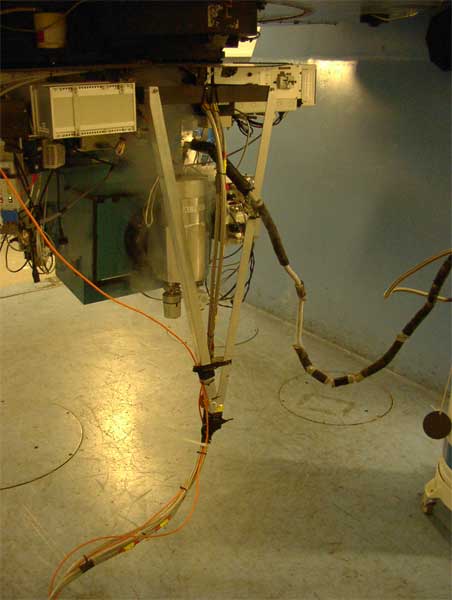
photo by: Frank Larsen
The Andalusian Faint Object Spectrometer and Camera (ALFOSC) on the Filter And Shutter Unit (FASU)
in the process of being refilled with liquid Nitrogen to keep the CCD at -120oC
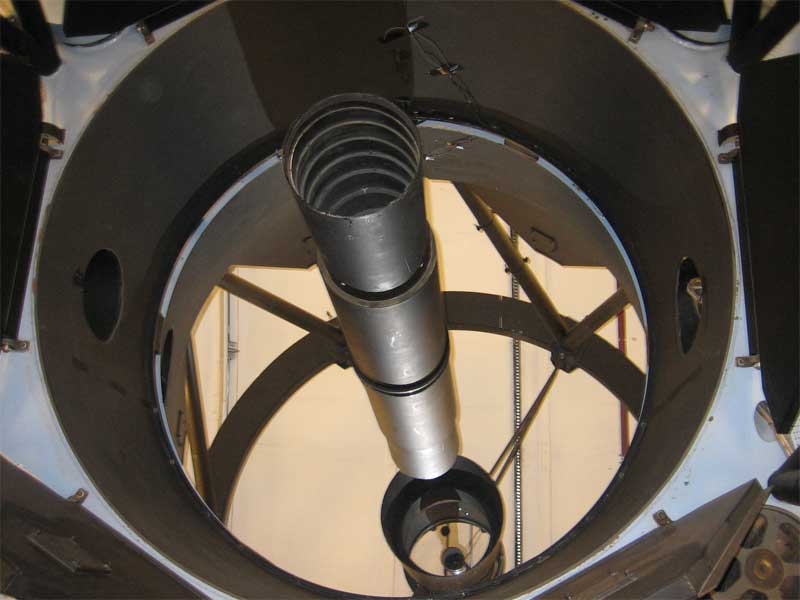
photo by: Frank Larsen
"Mirror, Mirror on the wall..." aperture of 2.56m should not be considered small...its huge.
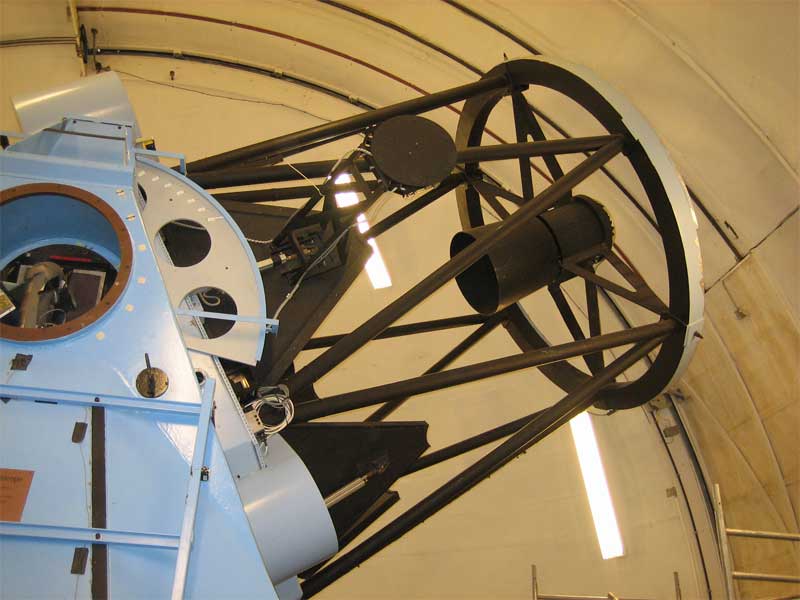
photo by: Frank Larsen
photo by: Lars Malmgren
NOT doing moonlight work
Please notice Ursa Minor and the faint red glow from the myriad of small status LEDs on the equipment inside the Dome.
Below we will present the images and our science which is the result of our visit to NOT.
We still need to do further study on our spectroscopy and our photometry of Eris and Pluto.
And a further comparative study of HH399 from our observation of M20 and 9 year old observations from HST, is also on the list.
Until then we hope that you will enjoy the images that has gone through the data reduction so far.
Planets and Dwarfplanets:
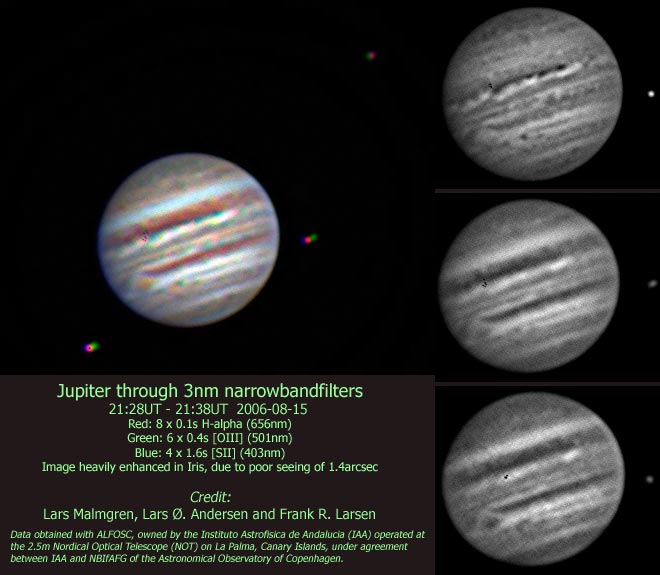
JUPITER with GRS and Red Junior
Taken at an air mass of 2.4, it just had to go wrong.
The resolution is not too great but nevertheless we still see a lot of cloud detail.
The images were taken through narrowband filters to bring the light intensity down,
as this telescope has not been build with planetary work in mind.

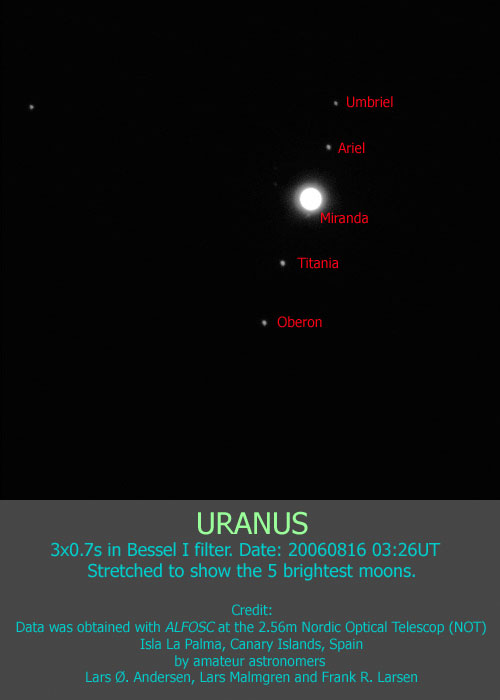
URANUS
We did actually get a few cloud details on this near infrared image of Uranus.
But we weren’t aware of the fact that one of the quite rare shadow casting moon transits was imminent at the exact
time we acquired the images of Uranus.
Now we’re a bit annoyed and disappointed that we didn’t follow Uranus closer so that we could have tried imaging Miranda passing in front of the planet disc. We will be back in 42years...
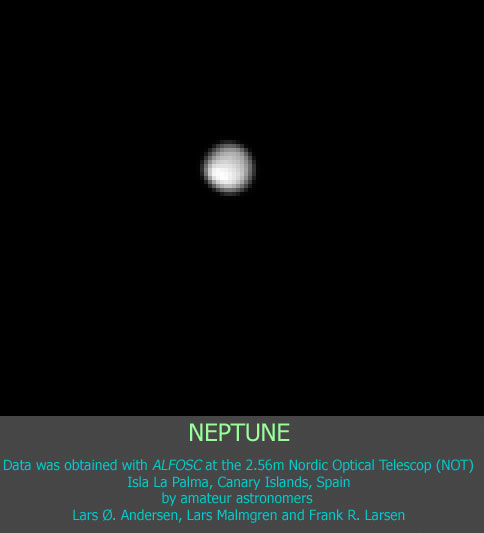
Neptune
To an ameateur, it's awsome to do this image. After the "degradation" of Pluto, this is the outermost planet in the solarsystem.
Normally we would image this planet as a dot, perhaps a big blop.
But in this Nearinfrared image of Neptune, we have even captured some intensity variation across the disc.

Pluto
Unfortunately seeing on the night of our observations was not optimal.
Our goal was to try and resolve the Pluto and Charon system but we had to make do with the more common picture of Pluto,
a slightly pear shaped blob.
But we’re still very happy since it was the first time any of us had observed Pluto.
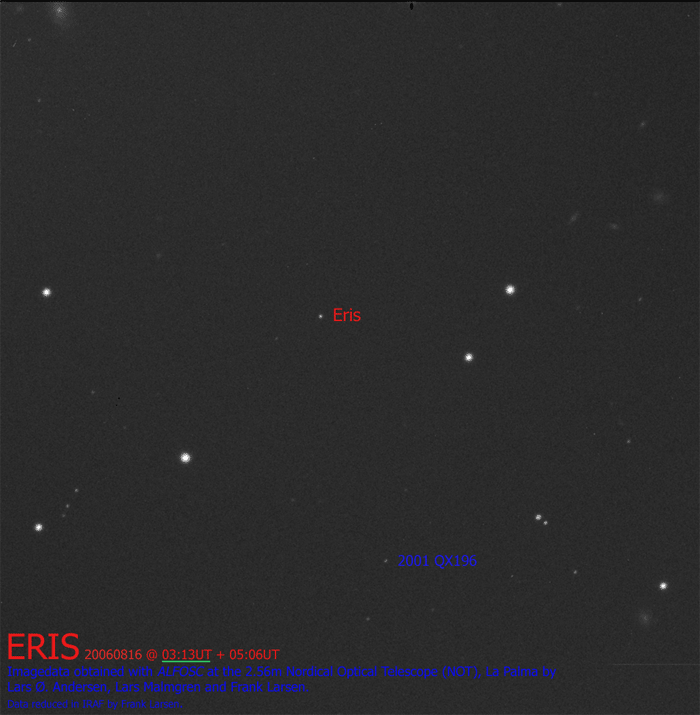
Dværg planet Eris og bælteasteroide 2001 QX196
This animation is not a science frame because the backgroundlevel and brightest stars has been clipped -
but it shows the movement of the dwarf planet Eris over the course of aprox. 2hours.
At the time of this image - Eris had not status of dwarf planet, but was only considered a transneptunian asteroid.
The morning this image was obtained, we read in our mail that the IAU had made official the first version of the new planet definition,
by which Eris (then 2003 UB313) would be a planet - this would later be changed.
This however could be one of the last pictures taken when Eris was still an asteroid....
First image is a stack of 2min + 4min + 5minutes in poor seeing and high airmass.
Second image is 2x5minutes in much better seeing and lower airmass - the difference is clear in the images.
As a bonus we also got asteroid 2001 QX196 at Mv=19.6
This was not planned and exicitement was high in the few minutes during datareduction, that it took to look it up at JPL horizons.
bummer - it was discovered in 2001.
The images are reduced in IRAF, but stacked in amateur program Registax3 and therefore there are still af few cosmic events present.
Deepsky
Trifid Nebula (M20)
This was going to be our main acquisition. It was supposed to be a mosaic in colors, but problems with thin clouds and poor transparency meant that we had to increase the exposure times quite a lot and so we had only time to acquire the H-alpha images.
Click on the image above to see the full-size picture which has a pixel resolution of 0.38”.
Seeing varied a good deal during the observations that lasted for a few hours, but the central parts were taken with a seeing better than
HH399 in M20
HH399 is a Herbig-Harow object with a jet of gas that is irradiated by the powerful UV light from the O7.5 star in the nebula.
Herbig-Harow objects are proto-stars that still has an accretion disk and is producing powerful jets from the poles.
The jet seen here in the image (white line pointing up in the top right corner) has previously been measured to have a velocity of
(F. Yusef-Zadeh 2005)
The proto-star itself is buried in or hidden behind the cloud of glowing hydrogene gas.
Autumn 2006, we will compare our observations of HH399 with those of HST from 1997 and 2002 and try to identify features and the relative position thereby doing a rough estimate of the speed of the material or shockwaves in the Jet.
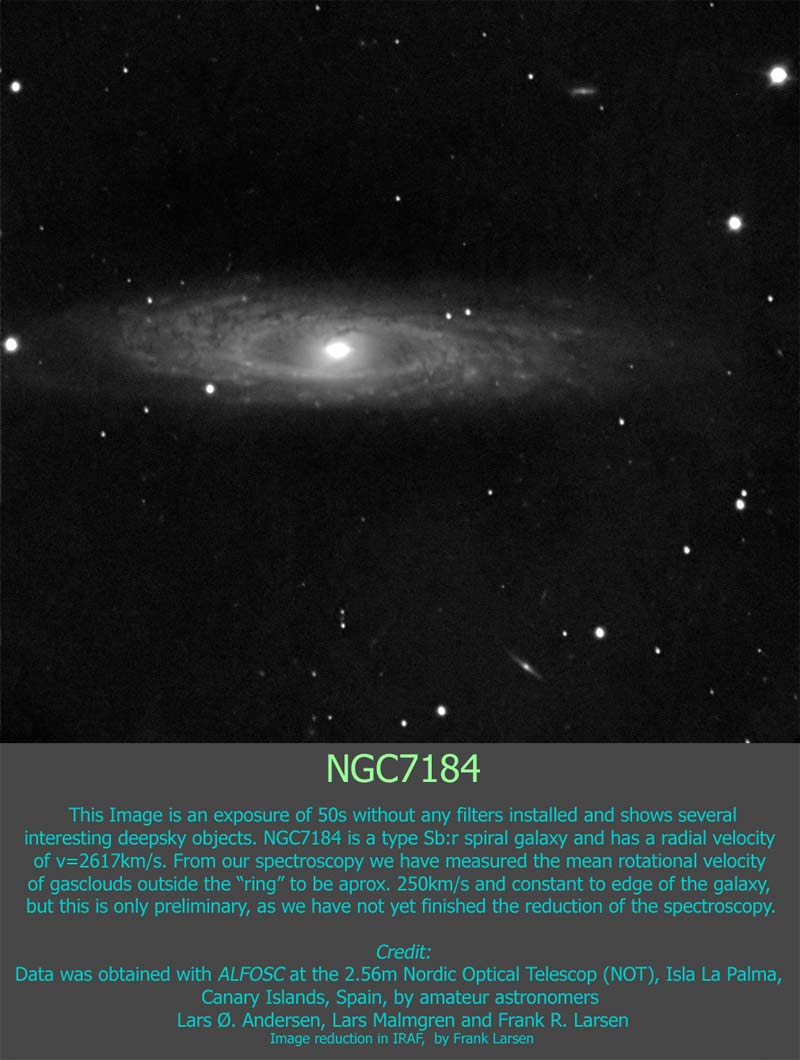
NGC7184
This is the galaxy we did our spectroscopy on. In part to determine its radial velocity and its rotationcurve.
We’re not done with this, but so far we have made a coarse estimate of the mean redshift to Rv=2643 km/s and the rotation of the outer parts to be around 250 km/s.
The interesting thing about the rotation velocity is that outside the prominent “ring”, it looks like its constant which could indicate the presence of “dark matter”.
Our preliminary analysis can be read here: Preliminary work on the spectre of NGC7184
NGC650 (M76)
This is one of the more faint planetary nebulas that Charles Messier observed in 1780.
Click on the image to see it in full-size.
This is one of our best images from that night and also one of the most basic.
It is composed of three single frames, two made with narrowband O[III] and H-alpha filters and the last with a standard blue (B) filter.
Resolution is 0.38"/pixel and seeing was between 0.75"-0.8"
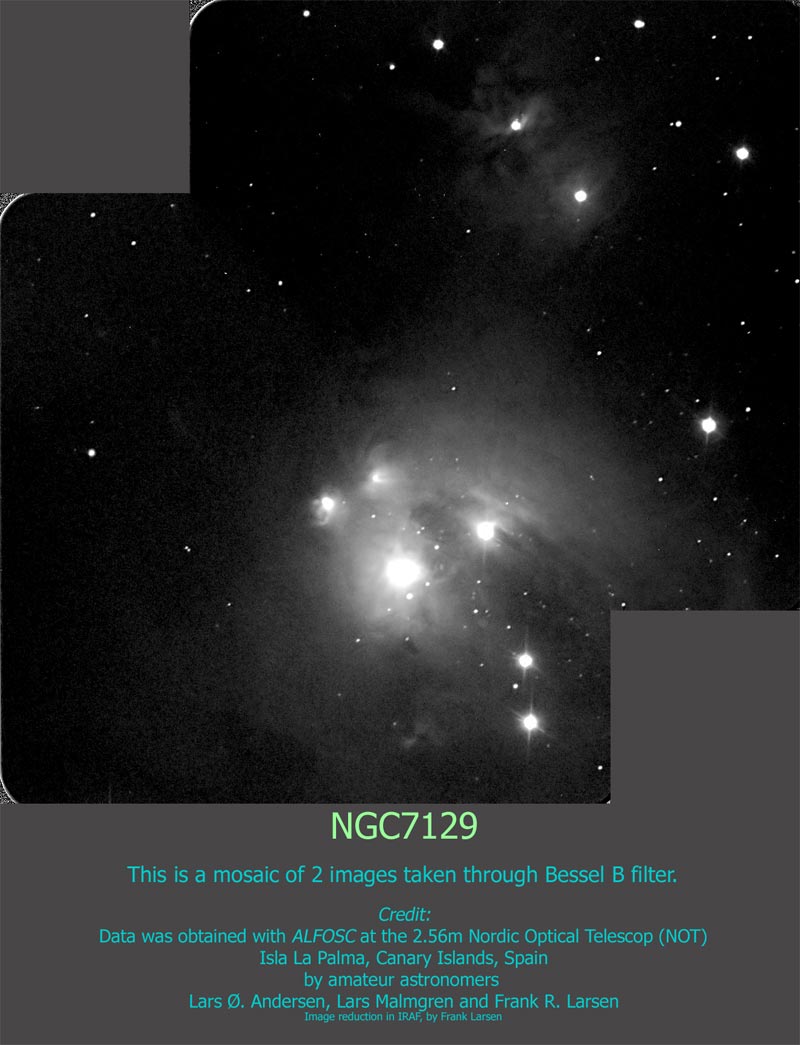

NGC7129
At the end of the night we were somewhat tired and began to make little mistakes.
The coordinates we had prepared for this object from home were slightly off,
and it became difficult to have time enough to acquire images for a color image of this object.
We wasted time because we had mixed the coordinated of the nebula and the large open cluster so we only got few frames of this very pretty cluster with combined reflection- and emission nebulas.
Above is a mosaic of 2 frames taken with B-band filter and below it 1 frame taken with a H-alpha filter.
This is what we so far got from the 255 frames taken in a period of 10 hours during the night between august 15th and 16th 2006 (including flats, bias and standards) which produced about 870 Mb of data.
Our conclusion is that the visit was an overwhelming success, but that we also have learnt a few lessons.
One should limit the object list so that more time is reserved for each object so that the quality of the end result can be better.
We have done a lot of work in the planning and this can be directly transferred to greatly enhance our amateur work.
The NOT functions flawless and very effective, so that firsttimers like ourselves can do a lot of descent observations without to much wasted time. The hard part (aprt from the planning that took several months) was getting into IRAF and learn the professional way of datareduction.
We are still learning – but are now ready to use our images for real science and the measurements we planned from start.
This will hopefully be a kick-start of sciencework from the lidemark group.
A huge thanks goes to
Jacob Clasen should have thanks for the daytime Tour-de-ORM where we visited Gran Telescopio Canarias, NOT and JKT.
We enjoyed meeting a fellow amateur that has ended up working 25years in astronomy heaven..
We would like to say thankyou to Astro physicist Michael J.D. Linden-Vørnle for his kind scientific counselling in the early phase of goal selection.
Lastly very important Thanks goes to the director of NOT,
With many kind regards
Lidemarkgroup
Lars Østergaard, Lars Malmgren og Frank Larsen
...ooOoo...
The following link is our "working desktop". it contains links to many of the documents we had to study thorughly before the observation run, and also shows a snapshot of our object list planning. Note the long list of candidates for the spectroscopy - only two ended up being usefull.
Its messy, but contains good links. Its in Danish - may come in english at a later time.
Last updated: 2006-10-11